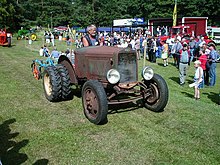Doodlebug tractor
The doodlebug of the 1940s was usually based on a 1920s or 1930s era Ford automobile which was then modified either by the complete removal or alteration of some of the vehicle body.
The conversion kits were expensive, some as much as $300, and farmers, hit hard by the Great Depression were a resourceful lot.
Magazines like Popular Mechanics and Mechanix Illustrated provided instructions for building a "Handy Henry" from that "old Ford sitting in your back yard, using simple tools anyone would have".
The cost to build a "Handy Henry" made from an old Model T car or truck was about $20, according to the 1936 edition of the Handy Man's Home Manual, and this provided a serviceable vehicle with rubber tires, a big truck rear end and two transmissions to make up for the gear reduction with which the kits came.
A government ordinance in 1940 (Kungörelse 1940: 440 om hänförande av vissa automobiler till fordonstypen motorredskap) was the first to set down rules for what modifications were necessary to change the class of vehicle from automobile to motorized farm implement, including a speed limit to 30 kilometers per hour (20 mph).

